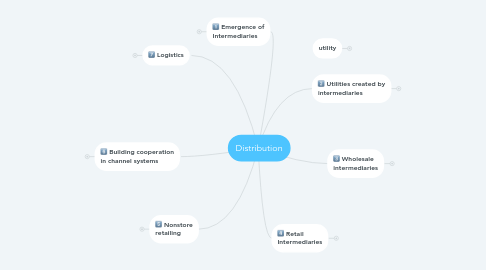
1. Emergence of Intermediaries
1.1. Why marketing needs intermediaries
1.1.1. they perform certain marketing tasks faster & cheaper than manufacturer
1.2. How intermediaries create exchange efficiency
1.2.1. reduces the number of exchange relationships
1.3. The value vs. the cost of intermediaries
1.3.1. value is usually > cost
2. Nonstore retailing
2.1. electronic retailing
2.1.1. online selling
2.2. telemarketing
2.2.1. selling over the phone
2.3. Vending machines, kiosks, carts
2.4. direct selling
2.4.1. selling to consumer in their home or workplace
2.5. multilevel marketing
2.5.1. sales people are independent contrators
2.5.2. earn commission on sales & sale of people under you
2.5.3. Avon
2.6. direct marketing
2.6.1. selling directly from manufacturer or intermediary to consumer
2.6.2. Omaha Steaks
3. Building cooperation in channel systems
3.1. corporate distribution systems
3.1.1. 1 firm owns all the organizations in the channel of distribution
3.1.2. Sherwin Williams
3.2. contractual distribution systems
3.2.1. members are bound by contract
3.2.2. 3 types:
3.2.2.1. franchise
3.2.2.1.1. McDonald's
3.2.2.2. Wholesaler-sponsored chains
3.2.2.2.1. Ace Hardward
3.2.2.3. retail cooperatives
3.2.2.3.1. Associated Grocers
3.3. administered distribution systems
3.3.1. producers manage all the marketing functions at the retail level
3.3.2. Kraft cheese
3.3.3. Scott Seed
3.4. supply chains
3.4.1. all linked activities that must be completed to get goods from raw materials to consumers
4. Logistics
4.1. Trains
4.1.1. largest % of goods shipped via rail
4.2. Trucks
4.2.1. 2nd largest % of goods shipped
4.2.2. small shipments to remote locations
4.3. Boat
4.3.1. inexpensive but slow
4.4. Pipelines
4.4.1. will be competing with rail
4.5. Planes
4.5.1. fast but expensive
4.6. intermodal shipping
4.6.1. uses multiple modes like rail + truck
4.7. the storage function
4.7.1. 2 kinds of facilities:
4.7.1.1. storage warehouse
4.7.1.1.1. keeps things for a long time
4.7.1.1.2. seasonal goods like lawn mowers
4.7.1.2. distribution warehouse
4.7.1.2.1. gather & redistribute products
4.7.1.2.2. FedEx & UPS
4.8. tracking goods
4.8.1. UPC codes
4.8.2. RFID tags
4.8.2.1. Walmart & Target plan to require
4.8.3. Bluetooth
5. utility
5.1. the value that a organizations add to goods or services
6. Utilities created by intermediaries
6.1. Form
6.1.1. producers provide form utility
6.2. Time
6.2.1. make available when needed
6.3. Place
6.3.1. having products where needed
6.4. Possession
6.4.1. transfer of ownership
6.5. Information
6.5.1. 2-way flow of communication
6.6. Service
6.6.1. fast, friendly service during & after sale
6.6.2. teaching customers how best to use product
7. Wholesale intermediaries
7.1. Merchant wholesalers
7.1.1. independently owned firms that take title good they handle
7.1.2. types:
7.1.2.1. rack jobbers
7.1.2.1.1. furnish racks & merchandise for retailers
7.1.2.2. cash-and-carry
7.1.2.2.1. serve mostly small retailers
7.1.2.3. drop shippers
7.1.2.3.1. ordered from retailers & other wholesalers
7.1.2.3.2. shipped from producer
7.2. Agent & brokers
7.2.1. bring buyers & sellers together to negotiate a deal
8. Retail Intermediaries
8.1. Retail distribution strategy - 3 categories
8.1.1. intensive
8.1.1.1. put product in as many outlets as possible
8.1.2. selective
8.1.2.1. send to only preferred group of retailers
8.1.3. exclusive
8.1.3.1. send to only 1 retailer in an area
